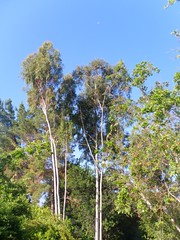Gum Trees
“. . . they’re planting windbreaks of of gum trees. Eucalyptus-comes from Australia. They say the gums grow ten feet a year. Why don’t you try a few rows and see what happens? In time they should back up the wind a little and they make grand firewood.”
- East of Eden by John Steinbeck
According to my 1988 copy of the Sunset Western Gardening Book, Eucalyptus are the most widely planted non-native trees in California and Arizona. It maintains that you can drive several hundred miles in parts of California and never lose sight of one. I am not sure that is the case any more for Southern California. I know that in my youth miles and miles of of Baseline and Foothill, from the foothill communities out through Fontana and beyond, were lined with eucalyptus. But, as vineyards and farms became housing developments and shopping malls the trees went with them.
The first eucalyptus came to California in the mid-1850s and over the years became popular, as noted by Steinbeck, for windbreaks and firewood. Additionally, many thousands of acres were planted in the hope of getting rich by selling the wood to the railroads to be as ties for the rails. Companies advertised in the newspapers and issued booklets and broadsides describing to unsuspecting souls the beauty of California and how a fortune could be be made from the trees they could provide when you bought their land. Sadly, the only people who got rich were the companies selling the land and trees. It seems that, of the some 500 species of eucalyptus, the trees they sold were singularly unsuited to be used as hardwood railroad ties as the wood would not stay straight after being cut and cured.
Even so, many types of eucalyptus have easily adapted to our lands which parallel similar climate zones in their native Australia. Thus they thrive here in Southern California’s Mediterranean climate and in what I consider to be the considerably harsher environment of California’s Central Valley.
There used to be, and perhaps still is, an interesting difference in how the trees were planted in the two areas. Growing up down here I was used to seeing the trees planted along roadsides and in rows between fields. However, in the Central Valley, along 99W near the town of Dunnigan for example, large farms would have seemingly hundreds of Eucalyptus all jammed in to one small corner of the property. The trees were planted so closely together that a cat would have had trouble walking between them. My friends from Davis were of the opinion that this was a clever way of scamming the homesteading requirements.
The government would give sections of land away in exchange for a promise to make certain improvements, including the planting of so many trees per acre. I am sure that the bureaucrats envisioned that these trees would be nicely spaced out over the land. That, of course, would interfere with the cultivation of crops and the farmers quickly figured out how to meet the letter of the law (if not the intent) while maximizing room for food or fodder.
The trees were still lovely.
successful project. Back home in Austin.
10 hours ago






